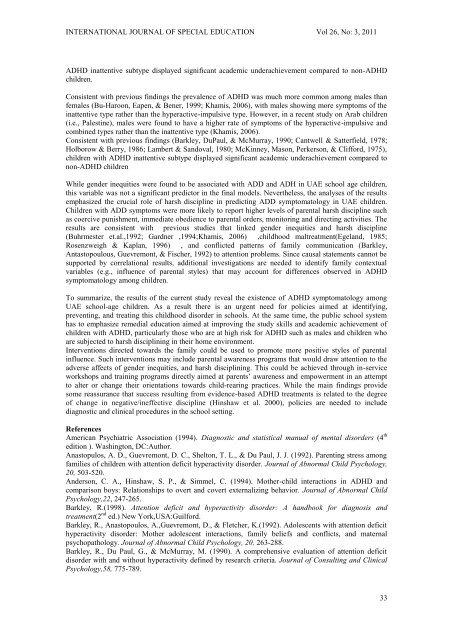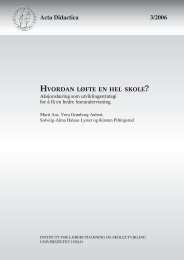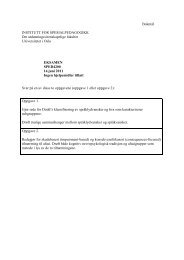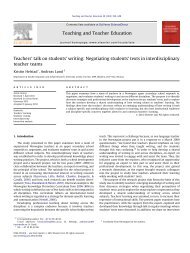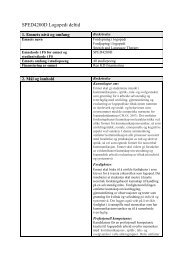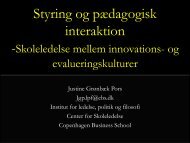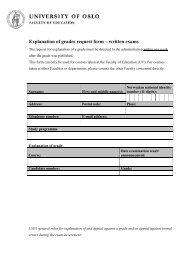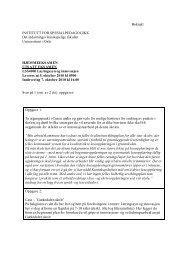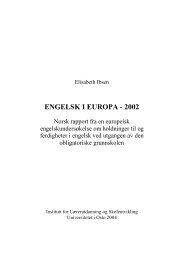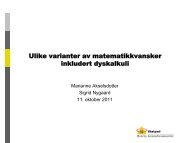INTERNATIONAL JOURNAL OF SPECIAL EDUCATION Vol 26, No: 3, 2011With respect to parent’s sociodemographics, no statistically significant differences were found betweenADHD children hyperactivity-impulsivity type and non- ADHD children, in regard to family income aswell as the educational level of mothers and fathers. In other words, the hyperactivity and impulsivitysymptomatology in children with ADHD did not vary according to their diverse backgrounds.Among the family environment and parenting variables, the only significant differences found betweenADHD hyperactivity-impulsivity type and non- – ADHD children was on the gender inequities scale t(198) = -1.99, p = 0.04 with ADHD children hyperactivity-impulsivity type reported higher levels ofgender inequities (see Table 1). Children who reported that they were subjected to genderdiscrimination and bias in their families in terms of receiving rewards, support, help, empathy, andresponsive care-giving exhibited symptoms of hyperactivity-impulsivity more than children who didn’tsuffer from gender bias in their families.Logistic regression was used to predict ADHD hyperactivity-impulsivity type. The results indicated thatnone of the child characteristics, parent’s sociodemographics, and family environment and parentingwere significant predictors of ADHD hyperactivity-impulsivity type.Table 2. Logistic Regression Predicting ADHD Inattentive type and ADHD Hyperactive –Impulsive typeVariableADHDInattentive typeADHDHyperactive –Impulsivetypeb r p OR b r p ORGender 3.43 .17 31.04** .86 .08 2.36School Performance -.04 -.26 .95 .02 -.09 1.02Family Income .000 -.01 1.00 .00 -.11 1.00Father <strong>Education</strong> .58 .30 1.78 .25 .11 1.29Mother <strong>Education</strong> -3.32 -.18 .03 -.39 -.10 .67Family Ambiance -1.84 -.09 .83 -.48 -.08 .61Parental Support -.22 -.10 .79 -.07 -.03 .92Gender Inequities .23 .25 1.26 -.00 .14 .99Harsh Discipline -.58 .01 .55 .49 .12 1.63Gender is coded: Male=1; Female=0. School Performance is coded: Cumulative Average. <strong>Education</strong>al level of Mothersand Fathers are coded in Years. Family Income is coded in Dirham. Family Ambiance is coded: 5-point scale ranging from7 to 35. Parental Support (PSC) is coded: 5-point ranging scale ranging from 10 to 100.Gender Inequities is coded: 5-pointranging scale ranging from 8 to 40 Harsh Discipline (HD) is coded: 5-point scale ranging from 6 to 30.* P < .01; * * P < .001DiscussionThe results of the current study indicate that the overall prevalence rate of ADHD was 12.5 % amongUnited Arab Emirates school-age children, with most children showing symptoms that are predominantlyinattentive, followed by those who are predominantly hyperactive-impulsive, and those who exhibit acombination of all symptoms- the combined type. Although the proportion of children identified asADHD may be higher than the estimates of the DSM (APA, 1994), the results are more or less consistentwith previous findings on UAE children which reported an overall prevalence rate of 14.9% (Bu-Haroon,Eapen, & Bener, 1999). Yet it was inconsistent with the results of a recent study on Arab children (i.e.,Palestinians) which has indicated a much higher prevalence rate of 34.1%. Differences in the prevalencerate of ADHD may be attributed to the fact that Palestinian children live in difficult circumstances, andexperience a considerable number of difficulties and stressors which may engender substantial harm tothem and make them more susceptible to the development and/or maintenance of the disorder (Khamis,2006). Nevertheless, the results of this study yielded similar rates of ADHD among children fromvarious countries (Baumgaertel, Wolraich, & Dietrich, 1995; Gaub & Carlson, 1997; Hinshaw ,1994;Pineda, Ardila, Rosselli, Arias, Henao, Gomez, Mejia, & Miranda, 1999). This is likely due to thesimilarity in research design, which relied on teachers’ ratings in which prominent symptoms were onlydisplayed in the school setting. An earlier study carried out in UAE (Daradkeh, 1993) noted that teachersmay be more accurate in their ratings of ADHD among school- aged children. Also, consistent withprevious findings (Barkley, DuPaul, & McMurray, 1990; Cantwell & Satterfield, 1978; Holborow &Berry, 1986; Lambert & Sandoval, 1980; McKinney, Mason, Perkerson, & Clifford, 1975), children with32
INTERNATIONAL JOURNAL OF SPECIAL EDUCATION Vol 26, No: 3, 2011ADHD inattentive subtype displayed significant academic underachievement compared to non-ADHDchildren.Consistent with previous findings the prevalence of ADHD was much more common among males thanfemales (Bu-Haroon, Eapen, & Bener, 1999; Khamis, 2006), with males showing more symptoms of theinattentive type rather than the hyperactive-impulsive type. However, in a recent study on Arab children(i.e., Palestine), males were found to have a higher rate of symptoms of the hyperactive-impulsive andcombined types rather than the inattentive type (Khamis, 2006).Consistent with previous findings (Barkley, DuPaul, & McMurray, 1990; Cantwell & Satterfield, 1978;Holborow & Berry, 1986; Lambert & Sandoval, 1980; McKinney, Mason, Perkerson, & Clifford, 1975),children with ADHD inattentive subtype displayed significant academic underachievement compared tonon-ADHD childrenWhile gender inequities were found to be associated with ADD and ADH in UAE school age children,this variable was not a significant predictor in the final models. Nevertheless, the analyses of the resultsemphasized the crucial role of harsh discipline in predicting ADD symptomatology in UAE children.Children with ADD symptoms were more likely to report higher levels of parental harsh discipline suchas coercive punishment, immediate obedience to parental orders, monitoring and directing activities. Theresults are consistent with previous studies that linked gender inequities and harsh discipline(Buhrmester et.al.,1992; Gardner ,1994;Khamis, 2006) ,childhood maltreatment(Egeland, 1985;Rosenzweigh & Kaplan, 1996) , and conflicted patterns of family communication (Barkley,Antastopoulous, Guevremont, & Fischer, 1992) to attention problems. Since causal statements cannot besupported by correlational results, additional investigations are needed to identify family contextualvariables (e.g., influence of parental styles) that may account for differences observed in ADHDsymptomatology among children.To summarize, the results of the current study reveal the existence of ADHD symptomatology amongUAE school-age children. As a result there is an urgent need for policies aimed at identifying,preventing, and treating this childhood disorder in schools. At the same time, the public school systemhas to emphasize remedial education aimed at improving the study skills and academic achievement ofchildren with ADHD, particularly those who are at high risk for ADHD such as males and children whoare subjected to harsh disciplining in their home environment.Interventions directed towards the family could be used to promote more positive styles of parentalinfluence. Such interventions may include parental awareness programs that would draw attention to theadverse affects of gender inequities, and harsh disciplining. This could be achieved through in-serviceworkshops and training programs directly aimed at parents’ awareness and empowerment in an attemptto alter or change their orientations towards child-rearing practices. While the main findings providesome reassurance that success resulting from evidence-based ADHD treatments is related to the degreeof change in negative/ineffective discipline (Hinshaw et al. 2000), policies are needed to includediagnostic and clinical procedures in the school setting.ReferencesAmerican Psychiatric Association (1994). Diagnostic and statistical manual of mental disorders (4 thedition ). Washington, DC:Author.Anastopulos, A. D., Guevremont, D. C., Shelton, T. L., & Du Paul, J. J. (1992). Parenting stress amongfamilies of children with attention deficit hyperactivity disorder. <strong>Journal</strong> of Abnormal Child Psychology,20, 503-520.Anderson, C. A., Hinshaw, S. P., & Simmel, C. (1994). Mother-child interactions in ADHD andcomparison boys: Relationships to overt and covert externalizing behavior. <strong>Journal</strong> of Abnormal ChildPsychology,22, 247-265.Barkley, R.(1998). Attention deficit and hyperactivity disorder: A handbook for diagnosis andtreatment(2 nd ed.) New York,USA:Guilford.Barkley, R., Anastopoulos, A.,Guevremont, D., & Fletcher, K.(1992). Adolescents with attention deficithyperactivity disorder: Mother adolescent interactions, family beliefs and conflicts, and maternalpsychopathology. <strong>Journal</strong> of Abnormal Child Psychology, 20, 263-288.Barkley, R., Du Paul, G., & McMurray, M. (1990). A comprehensive evaluation of attention deficitdisorder with and without hyperactivity defined by research criteria. <strong>Journal</strong> of Consulting and ClinicalPsychology,58, 775-789.33
- Page 1 and 2: INTERNATIONAL JOURNAL OF SPECIAL ED
- Page 3 and 4: INTERNATIONAL JOURNAL OF SPECIAL ED
- Page 5 and 6: INTERNATIONAL JOURNAL OF SPECIAL ED
- Page 7 and 8: INTERNATIONAL JOURNAL OF SPECIAL ED
- Page 9 and 10: INTERNATIONAL JOURNAL OF SPECIAL ED
- Page 11 and 12: INTERNATIONAL JOURNAL OF SPECIAL ED
- Page 13 and 14: INTERNATIONAL JOURNAL OF SPECIAL ED
- Page 15 and 16: INTERNATIONAL JOURNAL OF SPECIAL ED
- Page 17 and 18: INTERNATIONAL JOURNAL OF SPECIAL ED
- Page 19 and 20: INTERNATIONAL JOURNAL OF SPECIAL ED
- Page 21 and 22: INTERNATIONAL JOURNAL OF SPECIAL ED
- Page 23 and 24: INTERNATIONAL JOURNAL OF SPECIAL ED
- Page 25 and 26: INTERNATIONAL JOURNAL OF SPECIAL ED
- Page 27 and 28: StronglyDisagreeDisagreeNeutralAgre
- Page 29 and 30: INTERNATIONAL JOURNAL OF SPECIAL ED
- Page 31: INTERNATIONAL JOURNAL OF SPECIAL ED
- Page 35 and 36: INTERNATIONAL JOURNAL OF SPECIAL ED
- Page 37 and 38: INTERNATIONAL JOURNAL OF SPECIAL ED
- Page 39 and 40: INTERNATIONAL JOURNAL OF SPECIAL ED
- Page 41 and 42: INTERNATIONAL JOURNAL OF SPECIAL ED
- Page 43 and 44: INTERNATIONAL JOURNAL OF SPECIAL ED
- Page 45 and 46: INTERNATIONAL JOURNAL OF SPECIAL ED
- Page 47 and 48: INTERNATIONAL JOURNAL OF SPECIAL ED
- Page 49 and 50: INTERNATIONAL JOURNAL OF SPECIAL ED
- Page 51 and 52: INTERNATIONAL JOURNAL OF SPECIAL ED
- Page 53 and 54: INTERNATIONAL JOURNAL OF SPECIAL ED
- Page 55 and 56: INTERNATIONAL JOURNAL OF SPECIAL ED
- Page 57 and 58: INTERNATIONAL JOURNAL OF SPECIAL ED
- Page 59 and 60: INTERNATIONAL JOURNAL OF SPECIAL ED
- Page 61 and 62: INTERNATIONAL JOURNAL OF SPECIAL ED
- Page 63 and 64: INTERNATIONAL JOURNAL OF SPECIAL ED
- Page 65 and 66: INTERNATIONAL JOURNAL OF SPECIAL ED
- Page 67 and 68: INTERNATIONAL JOURNAL OF SPECIAL ED
- Page 69 and 70: Percent Correct (as of TA) .Percent
- Page 71 and 72: INTERNATIONAL JOURNAL OF SPECIAL ED
- Page 73 and 74: INTERNATIONAL JOURNAL OF SPECIAL ED
- Page 75 and 76: INTERNATIONAL JOURNAL OF SPECIAL ED
- Page 77 and 78: INTERNATIONAL JOURNAL OF SPECIAL ED
- Page 79 and 80: INTERNATIONAL JOURNAL OF SPECIAL ED
- Page 81 and 82: INTERNATIONAL JOURNAL OF SPECIAL ED
- Page 83 and 84:
INTERNATIONAL JOURNAL OF SPECIAL ED
- Page 85 and 86:
INTERNATIONAL JOURNAL OF SPECIAL ED
- Page 87 and 88:
INTERNATIONAL JOURNAL OF SPECIAL ED
- Page 89 and 90:
INTERNATIONAL JOURNAL OF SPECIAL ED
- Page 91 and 92:
INTERNATIONAL JOURNAL OF SPECIAL ED
- Page 93 and 94:
INTERNATIONAL JOURNAL OF SPECIAL ED
- Page 95 and 96:
INTERNATIONAL JOURNAL OF SPECIAL ED
- Page 97 and 98:
INTERNATIONAL JOURNAL OF SPECIAL ED
- Page 99 and 100:
INTERNATIONAL JOURNAL OF SPECIAL ED
- Page 101 and 102:
INTERNATIONAL JOURNAL OF SPECIAL ED
- Page 103 and 104:
INTERNATIONAL JOURNAL OF SPECIAL ED
- Page 105 and 106:
INTERNATIONAL JOURNAL OF SPECIAL ED
- Page 107 and 108:
INTERNATIONAL JOURNAL OF SPECIAL ED
- Page 109 and 110:
INTERNATIONAL JOURNAL OF SPECIAL ED
- Page 111 and 112:
INTERNATIONAL JOURNAL OF SPECIAL ED
- Page 113 and 114:
INTERNATIONAL JOURNAL OF SPECIAL ED
- Page 115 and 116:
INTERNATIONAL JOURNAL OF SPECIAL ED
- Page 117 and 118:
INTERNATIONAL JOURNAL OF SPECIAL ED
- Page 119 and 120:
INTERNATIONAL JOURNAL OF SPECIAL ED
- Page 121 and 122:
INTERNATIONAL JOURNAL OF SPECIAL ED
- Page 123 and 124:
INTERNATIONAL JOURNAL OF SPECIAL ED
- Page 125 and 126:
INTERNATIONAL JOURNAL OF SPECIAL ED
- Page 127 and 128:
INTERNATIONAL JOURNAL OF SPECIAL ED
- Page 129 and 130:
INTERNATIONAL JOURNAL OF SPECIAL ED
- Page 131 and 132:
INTERNATIONAL JOURNAL OF SPECIAL ED
- Page 133 and 134:
INTERNATIONAL JOURNAL OF SPECIAL ED
- Page 135 and 136:
INTERNATIONAL JOURNAL OF SPECIAL ED
- Page 137 and 138:
INTERNATIONAL JOURNAL OF SPECIAL ED
- Page 139 and 140:
INTERNATIONAL JOURNAL OF SPECIAL ED
- Page 141 and 142:
INTERNATIONAL JOURNAL OF SPECIAL ED
- Page 143 and 144:
INTERNATIONAL JOURNAL OF SPECIAL ED
- Page 145 and 146:
INTERNATIONAL JOURNAL OF SPECIAL ED
- Page 147 and 148:
INTERNATIONAL JOURNAL OF SPECIAL ED
- Page 149 and 150:
INTERNATIONAL JOURNAL OF SPECIAL ED
- Page 151 and 152:
INTERNATIONAL JOURNAL OF SPECIAL ED
- Page 153 and 154:
INTERNATIONAL JOURNAL OF SPECIAL ED
- Page 155 and 156:
INTERNATIONAL JOURNAL OF SPECIAL ED
- Page 157 and 158:
INTERNATIONAL JOURNAL OF SPECIAL ED
- Page 159 and 160:
INTERNATIONAL JOURNAL OF SPECIAL ED
- Page 161 and 162:
INTERNATIONAL JOURNAL OF SPECIAL ED
- Page 163 and 164:
INTERNATIONAL JOURNAL OF SPECIAL ED
- Page 165 and 166:
INTERNATIONAL JOURNAL OF SPECIAL ED
- Page 167 and 168:
INTERNATIONAL JOURNAL OF SPECIAL ED
- Page 169 and 170:
INTERNATIONAL JOURNAL OF SPECIAL ED
- Page 171 and 172:
INTERNATIONAL JOURNAL OF SPECIAL ED
- Page 173 and 174:
INTERNATIONAL JOURNAL OF SPECIAL ED
- Page 175 and 176:
INTERNATIONAL JOURNAL OF SPECIAL ED
- Page 177 and 178:
INTERNATIONAL JOURNAL OF SPECIAL ED
- Page 179 and 180:
INTERNATIONAL JOURNAL OF SPECIAL ED
- Page 181 and 182:
INTERNATIONAL JOURNAL OF SPECIAL ED
- Page 183 and 184:
INTERNATIONAL JOURNAL OF SPECIAL ED
- Page 185 and 186:
INTERNATIONAL JOURNAL OF SPECIAL ED
- Page 187 and 188:
INTERNATIONAL JOURNAL OF SPECIAL ED
- Page 189 and 190:
INTERNATIONAL JOURNAL OF SPECIAL ED
- Page 191 and 192:
INTERNATIONAL JOURNAL OF SPECIAL ED
- Page 193 and 194:
INTERNATIONAL JOURNAL OF SPECIAL ED
- Page 195 and 196:
INTERNATIONAL JOURNAL OF SPECIAL ED
- Page 197 and 198:
INTERNATIONAL JOURNAL OF SPECIAL ED
- Page 199 and 200:
INTERNATIONAL JOURNAL OF SPECIAL ED
- Page 201 and 202:
INTERNATIONAL JOURNAL OF SPECIAL ED
- Page 203 and 204:
INTERNATIONAL JOURNAL OF SPECIAL ED
- Page 205 and 206:
INTERNATIONAL JOURNAL OF SPECIAL ED
- Page 207 and 208:
INTERNATIONAL JOURNAL OF SPECIAL ED
- Page 209 and 210:
INTERNATIONAL JOURNAL OF SPECIAL ED
- Page 211 and 212:
INTERNATIONAL JOURNAL OF SPECIAL ED
- Page 213 and 214:
INTERNATIONAL JOURNAL OF SPECIAL ED
- Page 215 and 216:
INTERNATIONAL JOURNAL OF SPECIAL ED
- Page 217 and 218:
INTERNATIONAL JOURNAL OF SPECIAL ED
- Page 219 and 220:
INTERNATIONAL JOURNAL OF SPECIAL ED
- Page 221 and 222:
INTERNATIONAL JOURNAL OF SPECIAL ED
- Page 223 and 224:
INTERNATIONAL JOURNAL OF SPECIAL ED
- Page 225 and 226:
INTERNATIONAL JOURNAL OF SPECIAL ED
- Page 227 and 228:
INTERNATIONAL JOURNAL OF SPECIAL ED
- Page 229 and 230:
INTERNATIONAL JOURNAL OF SPECIAL ED
- Page 231 and 232:
INTERNATIONAL JOURNAL OF SPECIAL ED
- Page 233 and 234:
INTERNATIONAL JOURNAL OF SPECIAL ED
- Page 235 and 236:
INTERNATIONAL JOURNAL OF SPECIAL ED
- Page 237 and 238:
INTERNATIONAL JOURNAL OF SPECIAL ED
- Page 239 and 240:
INTERNATIONAL JOURNAL OF SPECIAL ED
- Page 241 and 242:
INTERNATIONAL JOURNAL OF SPECIAL ED
- Page 243 and 244:
INTERNATIONAL JOURNAL OF SPECIAL ED
- Page 245 and 246:
INTERNATIONAL JOURNAL OF SPECIAL ED
- Page 247 and 248:
INTERNATIONAL JOURNAL OF SPECIAL ED
- Page 249 and 250:
INTERNATIONAL JOURNAL OF SPECIAL ED
- Page 251 and 252:
INTERNATIONAL JOURNAL OF SPECIAL ED
- Page 253 and 254:
INTERNATIONAL JOURNAL OF SPECIAL ED
- Page 255 and 256:
INTERNATIONAL JOURNAL OF SPECIAL ED
- Page 257 and 258:
INTERNATIONAL JOURNAL OF SPECIAL ED
- Page 259 and 260:
INTERNATIONAL JOURNAL OF SPECIAL ED
- Page 261 and 262:
INTERNATIONAL JOURNAL OF SPECIAL ED
- Page 263 and 264:
INTERNATIONAL JOURNAL OF SPECIAL ED
- Page 265 and 266:
INTERNATIONAL JOURNAL OF SPECIAL ED
- Page 267 and 268:
INTERNATIONAL JOURNAL OF SPECIAL ED
- Page 269 and 270:
INTERNATIONAL JOURNAL OF SPECIAL ED
- Page 271 and 272:
INTERNATIONAL JOURNAL OF SPECIAL ED
- Page 273 and 274:
INTERNATIONAL JOURNAL OF SPECIAL ED
- Page 275 and 276:
INTERNATIONAL JOURNAL OF SPECIAL ED
- Page 277 and 278:
INTERNATIONAL JOURNAL OF SPECIAL ED
- Page 279 and 280:
INTERNATIONAL JOURNAL OF SPECIAL ED
- Page 281 and 282:
INTERNATIONAL JOURNAL OF SPECIAL ED
- Page 283 and 284:
INTERNATIONAL JOURNAL OF SPECIAL ED
- Page 285 and 286:
INTERNATIONAL JOURNAL OF SPECIAL ED
- Page 287 and 288:
INTERNATIONAL JOURNAL OF SPECIAL ED
- Page 289 and 290:
INTERNATIONAL JOURNAL OF SPECIAL ED
- Page 291 and 292:
INTERNATIONAL JOURNAL OF SPECIAL ED
- Page 293 and 294:
INTERNATIONAL JOURNAL OF SPECIAL ED
- Page 295:
INTERNATIONAL JOURNAL OF SPECIAL ED


